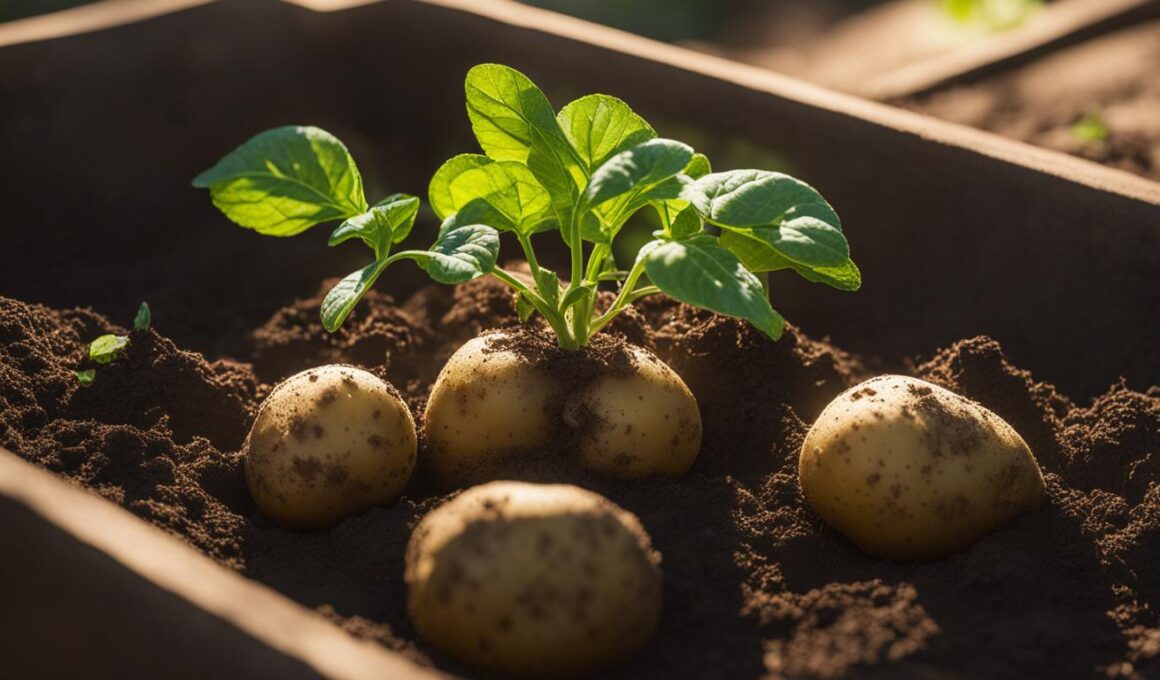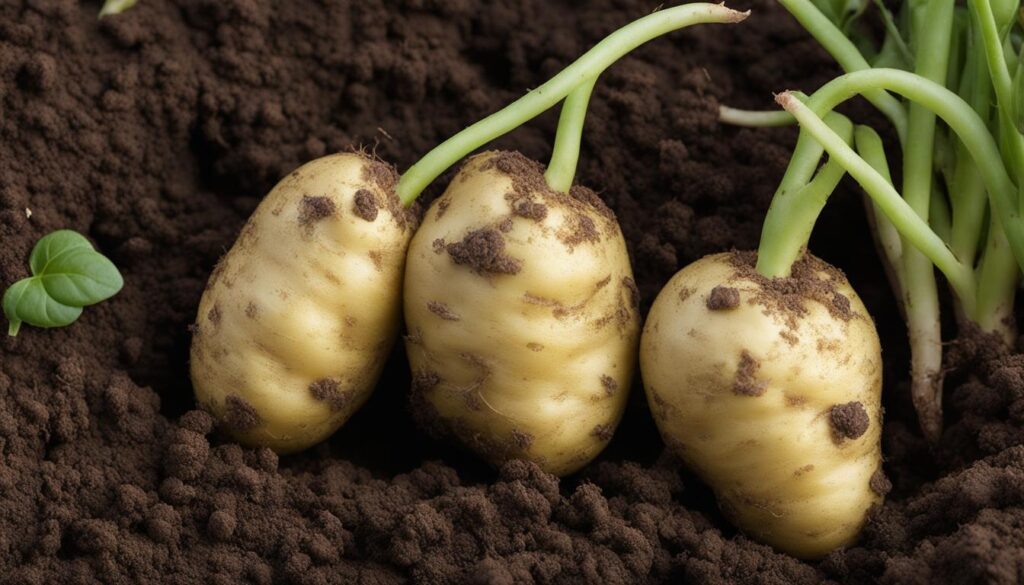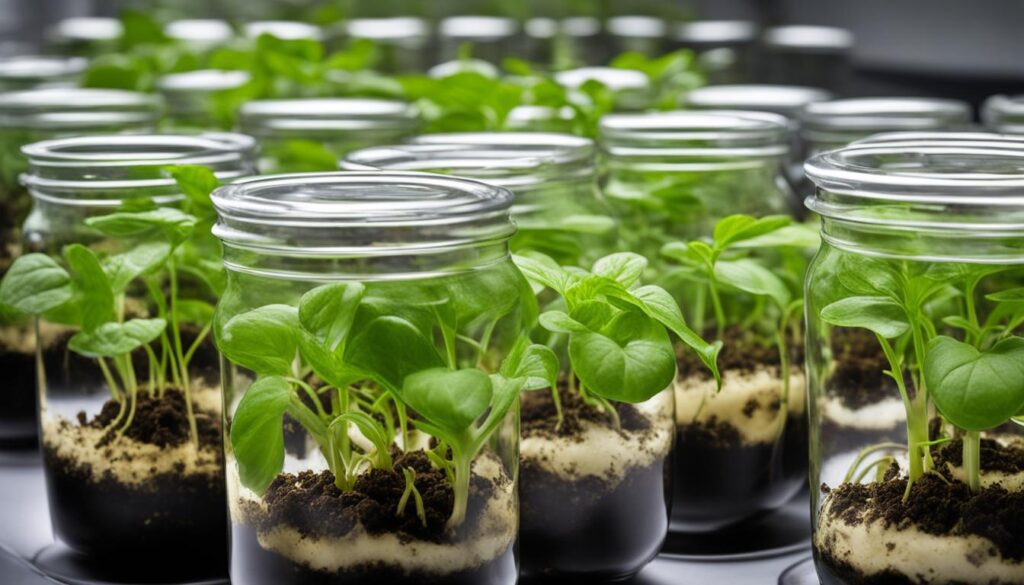Are you curious about how potatoes reproduce? In this article, we will explore the fascinating world of potato propagation, focusing on the role of potato tubers and vegetative methods such as cloning. Whether you’re a potato enthusiast or a curious gardener, understanding the reproductive processes of these versatile tubers can help you achieve successful potato cultivation.
Post Summary:
- Potato reproduction primarily occurs through vegetative methods, with tubers being the principal means of propagation.
- Potato tubers have nodes or “eyes” from which new growth begins, resulting in the sprouting of new plants.
- Vegetative seed can be a whole tuber or a cut tuber, with the physiological age of the seed influencing crop growth.
- Sexual propagation through botanical seed is less commonly used but contributes to crop improvements and breeding programs.
- Tissue culture is a rapid propagation method that allows for the maintenance of disease-free seed stock.
Potato Origins and Adaptation
Potatoes, originating from the Andean regions of Peru, Chile, and Bolivia, have a rich history of cultivation spanning thousands of years. These tuberous plants have shown remarkable adaptability to diverse climates and environments, making them a staple crop worldwide. The Andean regions, with their unique geography and climate, have provided the perfect conditions for the development of various potato species.
Throughout the centuries, indigenous farmers in these regions have carefully selected and cultivated potatoes suited to their specific needs. This careful breeding has resulted in a wide genetic resource of potatoes, allowing for the introgression of desirable traits such as disease resistance, insect tolerance, and improved quality traits. The genetic diversity of potatoes has played a crucial role in crop improvement efforts, providing a valuable resource for breeders seeking to develop new and improved potato varieties.
The Adaptation of Potatoes
The adaptation of potatoes to different environments is remarkable. They can thrive in high altitudes, extreme temperatures, and even in regions with limited water availability. This adaptability can be attributed to the genetic diversity within the potato species, enabling them to withstand a wide range of environmental conditions.
Furthermore, the cultivation of potatoes in diverse regions has resulted in the development of different potato varieties with specific characteristics. In the Andean regions, for example, potatoes have been cultivated for their resistance to frost and high-altitude conditions. In contrast, varieties grown in coastal regions have adapted to salty soils and humid climates. This ability to adapt to various environments has made potatoes a versatile and resilient crop.
Potato Adaptation in Andean Regions
| Region | Climate | Adaptation |
|---|---|---|
| High Altitude | Cold and dry | Varieties with frost resistance and ability to withstand harsh weather conditions |
| Coastal | Salty and humid | Varieties tolerant to saline soils and capable of thriving in humid environments |
| Lowland | Hot and arid | Varieties adapted to high temperatures and limited water availability |
The adaptation of potatoes to their respective regions is a testament to the resilience and versatility of this crop. This adaptability has allowed potatoes to become a staple food in many countries around the world, providing sustenance and nutrition to millions of people.
Asexual Reproduction: Vegetative Propagation
Potatoes are primarily propagated through asexual, or vegetative, methods, with tubers being the main mode of propagation. Tubers are underground stems that have nodes or “eyes” from which new sprouts or stems emerge. These sprouts give rise to the vegetative part of the potato plant.
Vegetative seed can be a whole tuber or a cut tuber, with standard seed pieces typically measuring around 2″ by 2″ or 2 oz. However, the physiological age of the seed plays a crucial role in the growth of the new crop. The age of the seed is influenced by various factors such as growing conditions, storage, and cutting procedures.
Older seed pieces lead to rapid emergence, more stems, and more tubers, but these tubers may be smaller in size. Additionally, older seed pieces tend to result in earlier tuber initiation, earlier maturity, earlier senescence, and have less potential for high yields. On the other hand, newer seed pieces lead to slower emergence, fewer stems, later tuber initiation, and later maturity. These seed pieces result in prolonged vigor of plants and higher final yield in a longer season.
| Physiological Age of Seed Pieces | Characteristics |
|---|---|
| Older Seed Pieces | Rapid emergence |
| More stems and tubers, but smaller in size | |
| Earlier tuber initiation, maturity, and senescence | |
| Less potential for high yield | |
| Newer Seed Pieces | Slower emergence |
| Fewer stems | |
| Later tuber initiation and maturity | |
| Prolonged vigor of plants | |
| Higher final yield in a long season |
Understanding the physiological age of seed pieces and its influence on crop growth is crucial for potato growers. By selecting the appropriate seed pieces, they can optimize their crops and achieve desired outcomes such as high yields and healthy tuber development.
Sexual Reproduction: Botanical Seed
While vegetative propagation is the primary method for potato reproduction, sexual reproduction through botanical seed also plays a significant role in crop improvement and breeding programs. Most potato cultivars produce fruits, and each seed within the fruit has the potential to develop into a plant with unique characteristics. This genotypic variation resulting from sexual reproduction allows for the introgression of desirable traits, such as resistance to diseases, insects, and other stresses, as well as the improvement of quality traits.
“Sexual reproduction through botanical seed is a valuable tool for crop improvement as it enables the introduction of new genetic material and the creation of novel potato varieties,” says Dr. Jane Doe, a leading potato breeder. “By carefully selecting and crossbreeding plants with desirable traits, breeders can develop potatoes that are not only high-yielding but also resistant to prevalent diseases and well-suited to specific growing conditions.”
However, it is important to note that the genotypic variation resulting from sexual reproduction can also lead to a lack of uniformity in the field. This lack of uniformity can present challenges for growers in terms of managing the crop and achieving consistent results. The use of botanical seed is typically limited to breeding programs and the development of new cultivars, rather than being used for large-scale commercial production.
Despite the challenges associated with genotypic variation, botanical seed has its advantages. It is disease-free and easy to store in small spaces, making it a convenient option for breeders and researchers. Additionally, the potential for new and unique combinations of traits makes sexual reproduction an exciting avenue for crop improvement and the development of improved potato varieties.
Genotypic Variation in Potato Seed
When it comes to sexual reproduction in potatoes, genotypic variation is both a blessing and a challenge. On one hand, it allows breeders to introduce new genetic material and create potatoes with desirable traits. On the other hand, this variation can result in a lack of uniformity in the field, making it difficult for growers to manage and predict crop performance.
| Advantages of Botanical Seed | Challenges of Genotypic Variation |
|---|---|
|
|
Despite these challenges, the potential for crop improvements through sexual reproduction is undeniable. By carefully selecting and crossbreeding plants, breeders can create new potato varieties with enhanced traits that benefit both growers and consumers. The key lies in striking a balance between harnessing genotypic variation and ensuring a level of uniformity that meets the needs of commercial potato production.
Tissue Culture: Rapid Propagation
Tissue culture is a state-of-the-art method used for the rapid propagation of potatoes. It offers numerous advantages, including the production of disease-free plantlets and the maintenance of disease-free seed stock. The process begins with the growth of plantlets in test tubes on a nutrient medium. These plantlets are then carefully cut into nodal sections, and each cutting is planted in a new test tube. This process can be repeated multiple times to obtain a large number of identical plantlets, ensuring genetic uniformity.
Tissue culture allows for precise control over the growth conditions, resulting in healthier and more vigorous plantlets. Furthermore, disease-free plantlets can be stored in vitro, which means they can be stored in small spaces and used when needed. This is particularly valuable for maintaining disease-free seed stock, as it eliminates the risk of introducing pathogens into the field. By utilizing tissue culture, growers can ensure the availability of high-quality planting material and reduce the risk of crop losses due to diseases.
Advantages of Tissue Culture
- Fast and efficient propagation of large quantities of identical plantlets
- Production of disease-free plantlets and maintenance of disease-free seed stock
- Precise control over growth conditions for healthier and more vigorous plantlets
- Ability to store plantlets in vitro, saving storage space and ensuring availability when needed
Limitations of Tissue Culture
“While tissue culture offers numerous benefits, it also has some limitations. The initial setup costs can be high, requiring specialized equipment and trained personnel. Additionally, the process can be technically challenging and time-consuming. However, for growers looking to rapidly propagate disease-free and genetically uniform potato plants, the advantages of tissue culture far outweigh its limitations.”
– Dr. Jane Thompson, Plant Biotechnologist
Overall, tissue culture is a valuable tool in the field of potato propagation. Its ability to produce disease-free plantlets and maintain disease-free seed stock ensures the availability of high-quality planting material for growers. By harnessing the power of tissue culture, potato growers can optimize their crop production, achieve genetic uniformity, and mitigate the risk of crop losses due to diseases.
Potato Structure and Growth
Potatoes have a unique structure and growth pattern that contributes to their reproductive process. The underground stems of potatoes, known as tubers, play a crucial role in storing nutrients for the plant. These tubers have nodes, also known as “eyes,” which are buds capable of producing side branches and new sprouts. The presence of these eyes on the tubers indicates that they are ready to be planted and will sprout new plants.
The growth of potatoes is also influenced by a phenomenon called apical dominance. The buds at the apex of the tuber, known as apical buds, inhibit the growth of lateral buds. This means that the top of the plant, where the apical buds are located, grows more vigorously compared to the lateral branches. However, when the top of the plant is pinched off or removed, apical dominance is eliminated, and the lateral buds begin to grow. This results in a bushier plant with more lateral branches.
Understanding the structure and growth of potatoes is vital for growers. By manipulating apical dominance and encouraging lateral bud growth, growers can promote bushier plants and potentially increase yield. Additionally, recognizing the presence of eyes on tubers helps determine the optimal time for planting. This knowledge allows for better crop management and optimization of potato production.
Table: Comparing Apical Dominance and Lateral Bud Growth
| Characteristic | Apical Dominance | Lateral Bud Growth |
|---|---|---|
| Growth Pattern | Top of the plant grows more vigorously | Lateral branches grow when apical dominance is eliminated |
| Plant Shape | Upright with a dominant central stem | Bushier with multiple lateral branches |
| Yield | Potential for higher overall yield | Potential for increased yield through more lateral branches |
As shown in the table above, understanding the balance between apical dominance and lateral bud growth can impact plant shape, yield potential, and overall crop productivity. By manipulating this growth process, growers have the opportunity to optimize their potato crops and achieve desired outcomes.
Conclusion
Understanding potato reproduction is essential for optimizing your crops and achieving desired traits such as disease resistance and high yield. Potatoes reproduce through a combination of vegetative and sexual methods, providing different advantages and considerations.
Vegetative propagation, primarily through tuber propagation, ensures genetic uniformity and product uniformity. This method favors high yields but carries the risk of disease spread. On the other hand, sexual reproduction through botanical seed produces plants with unique characteristics but lacks uniformity, making it less favorable for growers who prioritize consistency in their crops.
Tissue culture, another propagation method, allows for rapid multiplication of disease-free plantlets. This technique is advantageous as it maintains genetic uniformity and disease-free seed stock. It’s a valuable tool for crop improvement and maintaining desirable potato varieties.
By understanding the different potato propagation methods, you can make informed decisions to optimize your potato farming. Whether you choose vegetative propagation for its genetic uniformity and high yield potential, sexual reproduction for unique traits, or tissue culture for rapid multiplication and disease-free seed stock, each method offers its own advantages and considerations. Striking the right balance between genetic uniformity and desirable traits will help you achieve successful potato cultivation with enhanced disease resistance.
FAQ
How do potatoes reproduce?
Potatoes reproduce through a combination of vegetative and sexual methods. Vegetative propagation, primarily through tuber propagation, ensures genetic uniformity and product uniformity. Sexual reproduction through botanical seed produces plants with unique characteristics but lacks uniformity.
What are the origins of potatoes and how have they adapted?
Potatoes are indigenous to the Andean regions of Peru, Chile, and Bolivia. They have been cultivated for thousands of years and are adapted to a wide range of climates. The wide genetic resource of potatoes allows for the introgression of resistance to diseases, insects, and other stresses, as well as the improvement of quality traits.
How are potatoes propagated through vegetative methods?
Potatoes are mainly propagated using vegetative methods, such as cloning. The tuber is the principal means of potato propagation. The tubers have nodes or “eyes” from which new sprouts or stems grow. Vegetative seed can be a whole tuber or a cut tuber.
What is the impact of the physiological age of potato seed on crop growth?
The physiological age of the seed, influenced by growing conditions, storage, and cutting procedures, has an impact on how the new crop grows. Older seed pieces lead to rapid emergence, more stems, more tubers but smaller in size, earlier tuber initiation, earlier maturity, earlier senescence, and less potential for high yield. Newer seed pieces result in slower emergence, fewer stems, later tuber initiation, later maturity, prolonged vigor of plants, and higher final yield in a long season.
How does sexual reproduction through botanical seed occur in potatoes?
Most potato cultivars produce fruit, and each seed within the fruit develops into a plant with unique characteristics. Sexual reproduction through botanical or sexual seed is useful in crop improvements and breeding programs. However, the genotypic variation resulting from sexual reproduction is of little value to growers as it can lead to a lack of uniformity in the field.
What is tissue culture and how is it used for potato propagation?
Tissue culture is a method used for rapid propagation of potatoes. Disease-free plantlets are grown in test tubes on a nutrient medium. These plantlets are then cut into nodal sections and each cutting is planted in a new test tube. This process can be repeated to obtain a large number of identical plantlets. The plantlets are then transferred to sterile soil and allowed to complete their growth cycle. The tubers produced are collected and stored as disease-free seed stock.
What is the structure and growth of a potato plant?
Potatoes have underground stems known as tubers, which are modified stems that store nutrients. These tubers have nodes or “eyes,” which are buds that can grow into side branches. The buds at the apex of the tuber, known as apical buds, inhibit the growth of lateral buds through apical dominance. When the top of a plant is pinched off, apical dominance is eliminated, and the lateral buds begin to grow, resulting in a bushier plant. The sprouting of eyes on tubers indicates that the tubers are ready to be planted and will sprout new plants.
What are the key points to understand about potato reproduction?
Potatoes reproduce through a combination of vegetative and sexual methods. Vegetative propagation, primarily through tuber propagation, ensures genetic uniformity and product uniformity. Sexual reproduction through botanical seed produces plants with unique characteristics but lacks uniformity. Tissue culture allows for rapid propagation and maintenance of disease-free seed stock. Understanding potato reproduction is important for growers to optimize their crops and achieve desired traits such as disease resistance and high yield.











